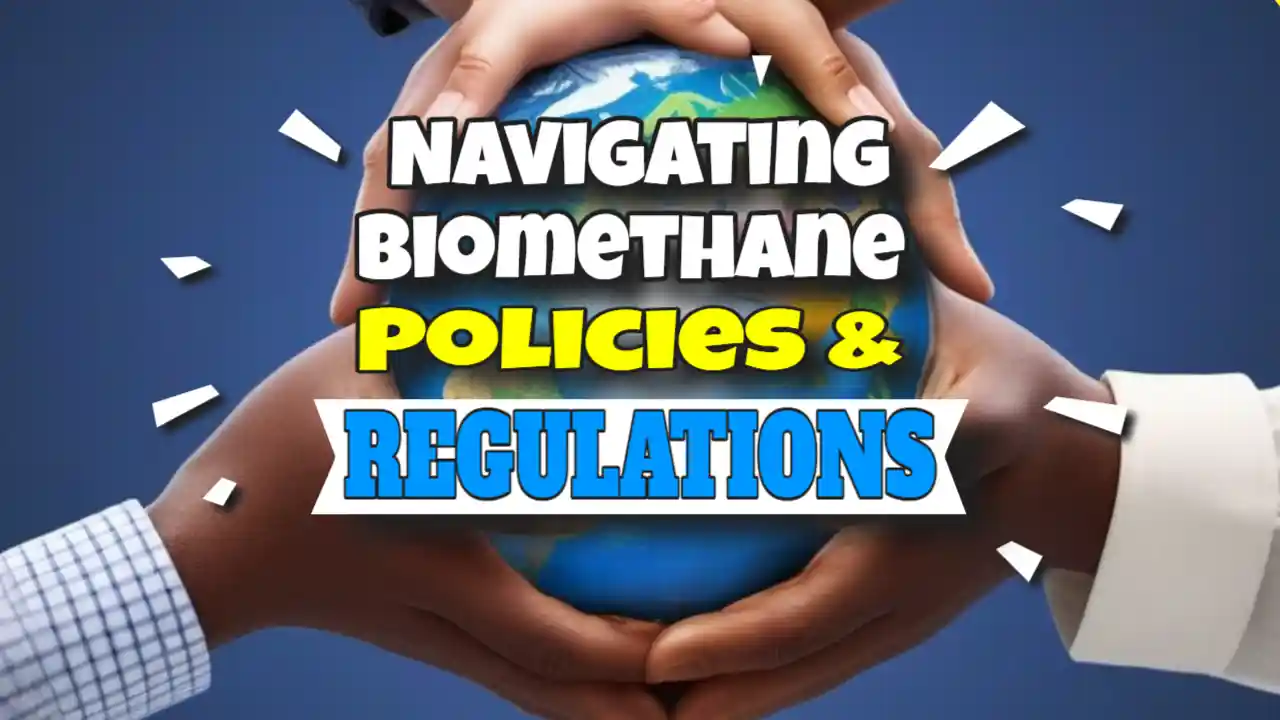Why Biomethane is so important! What if you could transform waste into a sustainable energy source that not only fuels your home but also helps combat climate change? This is the promise of biomethane, a renewable energy solution that is gaining traction as we seek cleaner alternatives to fossil fuels.
What You Will Learn
- Biomethane is a purified form of biogas, making it cleaner and more efficient for energy production compared to its raw counterpart.
- Key technologies such as anaerobic digestion and gas upgrading play crucial roles in converting organic waste into biomethane.
- The production of biomethane significantly reduces greenhouse gas emissions by utilizing organic waste that would otherwise decompose in landfills.
- Biomethane contributes to the carbon cycle by recycling carbon, thus promoting a sustainable energy solution that can help mitigate climate change.
- Shifting from fossil fuels to biomethane offers a highly sustainable and low-emission alternative, supporting a healthier planet.
- Engaging communities and advocating for supportive policies can enhance the production and utilization of biomethane, leading to a greener future.

Defining Biomethane and Its Production Process
Biomethane is a clean and renewable energy source derived from organic materials. It mainly consists of methane, which makes it similar to natural gas, but it is produced through biodegradable processes. Understanding biomethane’s production process is crucial for grasping its environmental benefits and its potential to replace fossil fuels.
Unlike biogas, which is a general term for a mixture of gases produced during the anaerobic digestion of organic matter, biomethane is a purified form of biogas. The main difference lies in the fact that biomethane meets the quality standards required to be injected into natural gas grids or used as vehicle fuel. In simple terms, you can think of biogas as the raw product, whereas biomethane is the finished product that’s ready for use!
What is Biomethane and How is it Different from Biogas?
Biomethane is created when biogas undergoes a process to remove impurities and increase the methane concentration. This means that biomethane is not only cleaner but also more efficient for energy production compared to biogas. With a higher methane content, biomethane can be easily integrated into existing gas infrastructure.
- Biogas: A mix of gases, primarily methane and carbon dioxide, produced from organic materials.
- Biomethane: A refined form of biogas, suitable for use in energy systems and meeting specific quality standards.
- Uses: Biomethane can power vehicles, heat homes, and even generate electricity, making it a versatile energy source.
Key Technologies for Biomethane Production
The production of biomethane relies on several key technologies that facilitate the conversion of organic materials into usable energy. These technologies not only enhance efficiency but also ensure that the process is environmentally friendly. Understanding these technologies is essential for anyone looking to delve into the world of biomethane.
- Anaerobic Digestion: A biological process that breaks down organic matter in the absence of oxygen, producing biogas.
- Gas Upgrading: Technologies like pressure swing adsorption or membrane separation are used to increase methane purity.
- Digestate Management: The leftover material from the digestion process can be used as fertilizer, contributing to a circular economy.
Anaerobic Digestion: The Core Process
Anaerobic digestion is the heart of biomethane production. During this process, microorganisms break down organic waste, such as food scraps or agricultural residues, in an oxygen-free environment. This not only produces biogas but also significantly reduces the waste volume, making it an effective waste management strategy.
Through anaerobic digestion, about 50% to 70% of the organic material can be converted into biogas. This biogas then undergoes upgrading to become biomethane. So, in a way, anaerobic digestion is a win-win process, helping us manage waste while also generating clean energy!
Upgrading Biogas to Biomethane
Upgrading biogas to biomethane involves several purification processes to enhance its quality. The goal is to remove impurities such as carbon dioxide, hydrogen sulfide, and water vapor. This ensures that the final product is suitable for use in natural gas systems.
- Pressure Swing Adsorption: A method that separates gases based on their adsorption characteristics.
- Membrane Separation: Uses selective membranes to allow only methane to pass through.
- Water Scrubbing: Involves using water to dissolve impurities and concentrate the methane.
These upgrading processes are crucial because they not only enhance the quality of the biomethane but also maximize energy recovery. This means that more energy can be harnessed from the same amount of raw biogas, making the process more effective overall!
Waste Management and Resource Recovery in Biomethane Production
One of the most exciting aspects of biomethane production is its role in waste management and resource recovery. By using organic waste materials, we can significantly reduce the amount of waste sent to landfills. This aligns with sustainable practices and contributes to a cleaner environment.
- Types of Waste Used: Food waste, agricultural residues, and livestock manure are commonly processed.
- Resource Recovery: The digestate from the digestion process can be repurposed as a nutrient-rich fertilizer.
- Environmental Benefits: Reduces methane emissions from landfills and lowers the carbon footprint associated with waste disposal.
Incorporating biomethane production into our waste management systems not only provides a renewable energy source but also leads to a more sustainable approach to handling waste. This truly showcases the potential of biomethane in supporting a healthier planet!
Assessing the Environmental Impact of Biomethane
The environmental impact of biomethane is a crucial aspect worth exploring. As we look for ways to combat climate change, understanding how biomethane can play a role is vital. It’s not just about generating energy but also about how it can help reduce greenhouse gas emissions and promote sustainability.
One of the primary benefits of biomethane is its potential to significantly lower the amount of carbon dioxide and methane released into the atmosphere. By capturing these gases and utilizing them for energy, we can make a substantial difference in our carbon footprint. As we dive deeper into this topic, it becomes clear why biomethane is gaining traction as a renewable energy source.
Biomethane’s Role in Reducing Greenhouse Gas Emissions
Biomethane is a powerful tool in the fight against greenhouse gases. When produced and used efficiently, it can help cut emissions in several ways. Here are some of the key points:
- Waste Reduction: Biomethane production often involves organic waste, which, if left untreated, would decompose and emit harmful gases.
- Energy Source: By using biomethane for energy, we replace fossil fuels that are high in emissions.
- Carbon Offset: Utilizing biomethane can offset emissions from traditional energy sources, making a significant impact on overall greenhouse gas levels.
These benefits make biomethane an essential player in reducing our overall carbon footprint. The shift towards using this renewable energy source is not just beneficial for the environment; it’s also a step towards a healthier planet.
Understanding the Carbon Cycle with Biomethane
To grasp biomethane’s environmental benefits, we need to understand the carbon cycle and how it relates to energy production. Biomethane closes the gap in the carbon cycle by capturing carbon released from organic materials. This cycle is crucial in maintaining balance in our ecosystems.
When we harness biomethane, we are essentially recycling carbon that would otherwise contribute to atmospheric pollution. Here’s how it fits in:
- Carbon Absorption: Plants absorb CO2, which is released during decomposition.
- Conversion to Biomethane: Organic waste is converted into biomethane through anaerobic digestion.
- Energy Use: The biomethane is then used for heating, electricity, or as vehicle fuel, completing the cycle.
This understanding underscores the importance of biomethane in achieving a sustainable environment. It demonstrates how our actions in energy production can influence the larger system of nature.
Comparative Analysis: Biomethane vs. Fossil Fuels
When comparing biomethane to traditional fossil fuels, the differences are stark. Fossil fuels contribute heavily to greenhouse gas emissions, while biomethane presents a cleaner alternative. Here’s a closer look at how they stack up:
| Feature | Biomethane | Fossil Fuels |
|---|---|---|
| Source | Renewable organic materials | Non-renewable resources |
| Emissions | Lower emissions | High emissions |
| Sustainability | Highly sustainable | Unsustainable |
By understanding these differences, we can appreciate the importance of transitioning to biomethane. It is not just about energy; it’s about a healthier planet.
Mitigating Climate Change through Emission Reduction
Biomethane plays a pivotal role in mitigating climate change. By reducing emissions, we can slow down global warming and its associated effects. Here are some strategies for leveraging biomethane:
- Increased Use: Encourage businesses and homes to switch to biomethane for heating and energy.
- Research and Development: Invest in technologies that improve biomethane production efficiency.
- Policy Support: Advocate for policies that promote renewable energy sources like biomethane.
These strategies highlight how communities and individuals can contribute to emission reduction. Working together, we can help combat climate change effectively!
Evaluating Carbon Footprint and Carbon Neutrality
Understanding our carbon footprint is vital as we navigate the transition to renewable energy. Biomethane offers pathways towards achieving carbon neutrality. It’s crucial to evaluate how much CO2 we emit and what we can do to balance it out.
When assessing carbon footprints, it’s helpful to consider:
- Energy Sources: Shift to biomethane to reduce reliance on fossil fuels.
- Waste Management: Implement programs for capturing organic waste for biomethane production.
- Community Engagement: Promote public awareness about biomethane’s benefits and encourage sustainable practices.
By taking these actions, we can collectively work towards a greener future. Remember, every little effort counts when aiming for a sustainable planet!
Biomethane Production Process
Anaerobic Digestion
Conversion of organic waste into biogas.
Conversion Rate: 50% – 70% of organic matter.
(Food scraps, agricultural residues)
Upgrading Processes
Enhancing the quality of biogas.
- Pressure Swing Adsorption
- Membrane Separation
- Water Scrubbing
Resource Recovery
Utilizing waste materials effectively.
Waste Types: Food, agricultural, livestock waste.
(Digestate as fertilizer)
Environmental Benefits
Reduces landfill waste and greenhouse gas emissions.
You Also May Like to Read Our Other Biomethane Articles Such as:
Frequently Asked Questions (FAQs)
1. What is biomethane?
Biomethane is a purified form of biogas that consists primarily of methane, making it a cleaner and more efficient energy source compared to raw biogas.
2. How is biomethane produced?
Biomethane is produced through anaerobic digestion, where microorganisms break down organic waste in the absence of oxygen. The resulting biogas is then upgraded to remove impurities and enhance methane concentration.
3. What are the environmental benefits of biomethane?
Biomethane significantly reduces greenhouse gas emissions, helps manage organic waste, and promotes sustainability by recycling carbon back into the carbon cycle.
4. How does biomethane compare to fossil fuels?
Biomethane is derived from renewable organic materials, has lower emissions, and is highly sustainable, whereas fossil fuels are non-renewable and contribute to high levels of greenhouse gas emissions.
5. What technologies are involved in biomethane production?
Key technologies include anaerobic digestion, gas upgrading methods such as pressure swing adsorption and membrane separation, as well as digestate management for resource recovery.
6. How can communities support biomethane production?
Communities can support biomethane production by engaging in advocacy for supportive policies, raising public awareness, and implementing waste management systems that incorporate biomethane production.





Leave a Reply